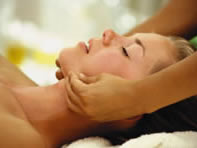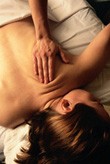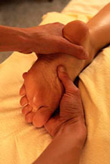FAQ
- What is Massage?
- What does Agape' mean?
- Does massage complement Chiropractic care?
- Why soft tissue is important?
- Massage supports chiropractic…?
- How to Receive a Massage?
|  |
|
|
Q: What is Massage?
A: Massage applies various techniques to muscular structure and soft tissue including, pressure, friction, kneading and stroking to alleviate muscle pain and tension. Regular massage can help reduce stress, and can help you become connected to your body.
Back to top |
Q: What does Agape' mean?
A: Agape' is a term to describe unconditional love- The kind of love that one receives from God.
Since this wonderful gift of touch has been bestowed, it is affecting individual's lives in the most remarkable ways- which can only be attributed to the gift of God's unconditional love for those whom He has created. Back to top |
Q: Does massage compliment Chiropractic care?
A: Therapeutic massage received regularly helps work out chronic muscular tension. Massage melts away a certain amount of tension in each session, and if received regularly, keeps tension from building up again. It helps you identify and correct patterns of holding tension. You can learn to relax and let go of tension you may not have been aware of.
Therapeutic massage and stretching can help you regain and maintain proper alignment. When muscles are relaxed and restored to their optimal length, correct posture and alignment are more easily sustained.
Massage can also trigger the relaxation response, relieving the negative effects of stress and restoring balance in the body. Some positive effects of the relaxation response include slower heart rate, deeper breathing, more relaxed muscles, and better internal circulation and digestion.
Back to top |
Q: Why soft tissue is important?
A: Addressing soft tissue problems is an important complement to chiropractic care. This is because muscles move joints, while ligaments and fascia support them. If a subluxation is adjusted without addressing related soft tissue problems, you may still experience pain. In addition, your tight muscles and shortened fascia can pull your joint out of alignment again.
Back to top |
Q: Massage supports chiropractic… ?
A: Recovery is normally faster and more complete when you address multiple components of your pain.
Chiropractic treatment often proceeds more easily with less discomfort, when soft tissue has been relaxed with massage.
Adjustments frequently last longer when muscle tension is released that might otherwise pull your joints out of alignment again.
Your total well-being is the goal.
Back to top |
Q: How to Receive a Massage?
A: Because massage may not be a part of a person’s contemporary cultural experience, many people feel uneasy about receiving their first massage. Here are a few guidelines to help you feel at ease, and gain the greatest benefit from your session:
1. Tell the therapist about area of your body that are injured, sore, or tense.
2. Mention any medical condition such as high blood pressure, heart problems, headaches, varicose veins, or recent surgery.
3. If you have any type of infectious disease such as a cold or flu, or a skin rash, it is important that this be mentioned also as massage will often increase the health risk of discomfort with these ailments.
4. During the session, close your eyes and allow yourself to relax as completely as possible. Focus your attention on breathing slowly and deeply.
5. Allow the therapist to move your limbs into position. Be limp like a rag doll and do not try to help move your arms, legs and head unless the therapist requests your assistance.
6. The therapist is a trained professional who will not do anything to hurt you. However, feel free to speak up if anything the therapist does is too painful, ticklish, or uncomfortable in any way.
7. Conversation is distracting to you and the therapist. As good massage requires the therapist’s concentration, please limit talking to feedback about the massage.
8. Massage is a healing and therapeutic treatment, and not a sexual service.
9. Many people fall asleep during a massage and this is normal. The therapist will gently wake you when it is time to turn over or end the massage.
It is our hope that your massage is both enjoyable and beneficial and this experience will be the beginning of a lifelong practice.
Back to top |
|
Myofascial Release:
Myofascial Release Therapy is an extremely effective hands-on technique that works by applying gentle sustained pressure to eliminate pain and restore flexibility and motion to the fascia (connective tissue). |  | Deep Tissue:
Using Deep Tissue we can assess the cause and type of conditions a patient presents, which is crucial to treating them successfully. This involves strong pressure used on "trigger points" and tendons to release contracted muscles and clear troubled areas. |  | Reflexology:
Reflexology is the art of touching points on feet, hands and ears that correspond directly with the organs, glands and other systems in the body. The reflex points communicate messages causing deep relaxation, detoxification, pain relief, stimulation of the immune and circulatory system, and facilitate an overall balance and well being. |  |
All Content © 2003 Agape' Therapeutic Massage |  Set Appointment Set Appointment | |
|
|